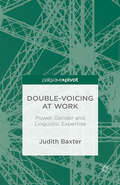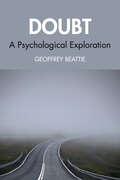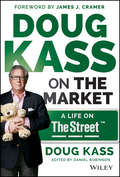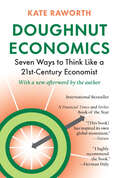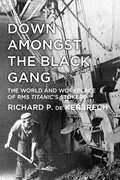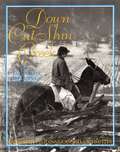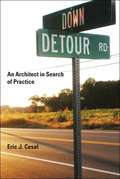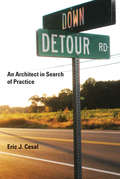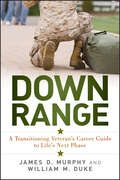- Table View
- List View
Double-voicing at Work: Power, Gender and Linguistic Expertise
by Judith BaxterThis book reveals how 'double-voicing' is an inherent and routine part of spoken interactions within institutional contexts. Baxter's research shows that women use double-voicing more than men as a means of gaining acceptance and approval in the workplace. Double-voicing thus involves an interplay between power, gender and linguistic expertise.
DoubleClick, Inc.
by Jacob Cohen Thomas D. FieldsExamines DoubleClick's capital structure from IPO. Discusses additional offering of common stock, stock splits, dividends, sale of convertible debt, repurchase of convertible debt, and repurchase of common stock.
DoubleDutch
by Frank V. Cespedes Matthew PrebleLawrence Coburn and Pankaj Prasad, co-founders of the event solution startup DoubleDutch, have to make a significant decision about their young company's sales function. DoubleDutch's key product was a mobile application (app) and event management platform that customers could use to better engage and connect with their event participants (e.g. attendees at a conference, employees at a quarterly sales meeting), and also to obtain detailed information from these participants to deliver a better future experience, understand how the event was received, and receive large amounts of valuable data. The company was growing quickly and rapidly adding new customers, but Coburn and Prasad wanted to make sure that in the drive to add new customers, existing clients whose contracts were expiring were not "slipping through the cracks" when it came time to renew. But who within the company should be responsible for renewals? Sales? The customer success team that helped customers develop and deploy the product? Or an entirely new team dedicated solely to renewals?
Doubling Down: Elon Musk's Big Bets in 2022
by David B. Yoffie Daniel Fisher2021 was a banner year for Elon Musk. CEO of the electric vehicle manufacturer Tesla, the aerospace manufacturer SpaceX, and a few smaller startups, Musk became the richest person on Earth after Tesla reached a market capitalization of $1 trillion and SpaceX a private valuation of $100 billion. Both companies made bet big on risky technologies. Now that they were leaders in booming industries, the task was to retain their lead. Musk had proposed a round of big new bets for each company: Tesla was to work with partners to rapidly expand battery production with a focus on lithium-iron phosphate batteries, and SpaceX was to launch thousands more of its Starlink satellites aboard Starship, the largest launch system ever devised. Meanwhile, Tesla faced litigation related to SEC complaints and safety concerns about its Autopilot driver-assistance system, and SpaceX's growing Starlink constellation similarly raised safety concerns. For Musk, the question was: should he consolidate gains and fix the operational, legal, and political problems before launching new initiatives, or should he proceed full speed ahead?
Doubt: A Psychological Exploration
by Geoffrey BeattieBlending the latest academic research with case studies of famous figures, this highly insightful book presents ‘doubt’ as a central concept for psychology. It is a concept which has been oddly neglected in the past, despite its ubiquitous nature and far-reaching influence. Exploring everything from self-doubt and impostor syndrome to the weaponisation of doubt with respect to climate change and the marketing of cigarettes, bestselling author Geoffrey Beattie navigates readers through the various ways doubt can start and develop, changing the individual in the process. Written in Beattie’s distinctive and engaging style, Doubt takes the reader into the lives of transformational thinkers, artists, scientists and writers to explore how and why doubt was crucial in their lives and how the likes of Kafka, Jung, Picasso and Turing succumbed to doubt or learned to control it. Beattie argues that doubt is central to the self; it can be either a safeguarding mechanism or a distraction, rational or irrational, systematic or random, healthy or pathological, productive or non-productive. The book helps readers to recognise how doubt may have been operating in their own lives and to identify how and when it has been used against us – for example, to prevent climate action – and at what personal and societal cost. Presenting a compelling case for why doubt cannot be ignored, this book is of major interest to academics from a wide range of disciplines, including social and cognitive psychology, clinical and counselling psychology, sport psychology, sociology, business studies, politics, art and literature, as well as the general public, who may well see something of themselves in its pages.
Doug Kass on the Market
by James J. Cramer Douglas A. KassBuild a bulletproof portfolio with advice from a top market expertDoug Kass on the Market: A Life on TheStreetTM provides investment advice and guidance from one of the most renowned traders in the world. Author Doug Kass distills his years of experience as a hedge fund manager and infamous short seller to share the theory, technique, and intuition that built his reputation and his portfolio. Anecdotes about interactions with Wall Street's most famous names, including Buffett, Cramer, and Cooperman, highlight tricks of the trade, essential value investor insight, and the secrets to being a smart short.Doug Kass's reputation as a savvy investor is well-earned and widely recognized. His work on Wall Street gained him heavyweight status, and the friendship, the respect, and the ear of some of the biggest names in finance. As a CNBC regular and 2013 Buffet Bear, Kass is widely known as a trusted source of wisdom and profitable insight. In Doug Kass on the Market, readers learn valuable lessons that that will help them make smarter investment decisions. Kass lists the most important things to know when evaluating a possible long or short investment, and explains the things you're not doing to optimize your portfolio. Topics include:Going against the grainData versus instinctValuation, bubbles, and momentumInterest rates, inflation, and the FedThe book also describes how to short a stock properly without losing out and discusses the C-suite conversations that fund managers would never tell a lay shareholder. Kass's record proves the value of his acumen, and this book contains a comprehensive account of his talent and techniques. All investors deserve a chance at a more robust portfolio, and Doug Kass on the Market provides the information and guidance that can make that happen.
Doug Rauch: Solving the American Food Paradox
by Ryan Johnson Jose B. AlvarezDoug Rauch, the former president of grocery store chain Trader Joe's, had long been troubled by the amount of food, especially fresh and healthy produce, which was wasted in the food system. Simultaneously, he was frustrated by the paradox he saw in the U.S. food system: rising food insecurity, broadly defined as a lack of access to enough food to fully meet basic needs at all times, concurrent with an obesity epidemic, suggesting that low-income communities lacked access not just to food in general, but to healthy foods in particular. Rauch believed he could build a non-profit grocery store model that took advantage of grocery stores' built-in waste and channeled that wasted food to be resold at a significant discount. Rauch faced significant challenges in the implementation and execution of his plan, notably legal hurdles related to selling products past their expiration date, marketing challenges, and convincing grocers to partner with him to combat waste. He had to carefully select a partner from a number of interested parties. Finally, he would need to change shopping, eating, and cooking behaviors of a community. In doing so, he hoped to leave a lasting positive health impact and a scalable model for change across the United States.
Doughnut Economics: Seven Ways to Think Like a 21st-Century Economist
by Kate Raworth*The Sunday Times Bestseller*A Financial Times Book of the Year*A Forbes Book of the Year*Winner of the Transmission Prize 2018*Longlisted for the FT/McKinsey Business Book of the Year Award 2017*Porchlight &“Best Business Book of 2017: Current Events & Public Affairs&”The book that redefines economics for a world in crisis.Economics is the mother tongue of public policy. It dominates our decision-making for the future, guides multi-billion-dollar investments, and shapes our responses to climate change, inequality, and other environmental and social challenges that define our times.Pity then, or more like disaster, that its fundamental ideas are centuries out of date yet are still taught in college courses worldwide and still used to address critical issues in government and business alike.That&’s why it is time, says renegade economist Kate Raworth, to revise our economic thinking for the 21st century. In Doughnut Economics, she sets out seven key ways to fundamentally reframe our understanding of what economics is and does. Along the way, she points out how we can break our addiction to growth; redesign money, finance, and business to be in service to people; and create economies that are regenerative and distributive by design.Named after the now-iconic &“doughnut&” image that Raworth first drew to depict a sweet spot of human prosperity (an image that appealed to the Occupy Movement, the United Nations, eco-activists, and business leaders alike), Doughnut Economics offers a radically new compass for guiding global development, government policy, and corporate strategy, and sets new standards for what economic success looks like.Raworth handpicks the best emergent ideas—from ecological, behavioral, feminist, and institutional economics to complexity thinking and Earth-systems science—to address this question: How can we turn economies that need to grow, whether or not they make us thrive, into economies that make us thrive, whether or not they grow?Simple, playful, and eloquent, Doughnut Economics offers game-changing analysis and inspiration for a new generation of economic thinkers.&“This is sharp, significant scholarship . . . Thrilling.&”—Times Higher Education&“Raworth&’s magnum opus . . . Fascinating.&”—Forbes&“Doughnut Economics shows how to ensure dignity and prosperity for all people.&”—Huffington Post
Dove and Real Beauty: Building a Brand with Purpose
by Mark R. Kramer Myriam Sidibe Gunjan VedaCase
Dove: Evolution of a Brand
by John DeightonExamines the evolution of Dove from functional brand to a brand with a point of view after Unilever designated it as a masterbrand, and expanded its portfolio to cover entries into a number of sectors beyond the original bath soap category. The development causes the brand team to take a fresh look at the cliches of the beauty industry. The result is the controversial Real Beauty campaign. As the campaign unfolds, Unilever learns to use the Internet, and particularly social network media like YouTube, to manage controversy.
Dovernet
by Natalie Kindred Robert L. SimonsThis case illustrates the implications of using stringent performance measurement systems to create performance pressure, motivate employee achievement, and sharpen a firm's competitiveness. It opens by describing the downsides of the ruthlessly competitive culture at Zynga, a young, successful online gaming company. A similar data-driven performance measurement system is employed at Dovernet, a Vancouver-based provider of enterprise communications and social-networking technologies. Dovernet's founder and CEO sees performance measurement systems as vital for cultivating the competitive, innovative workforce necessary for Dovernet to win in a fiercely competitive industry. Dovernet uses quarterly top-down reviews and stack ranking (with major implications for bonuses), as well as bottom-up reviews, to reward top achievers and put low performers on notice. The practical challenges of applying this system are illustrated in three brief vignettes. In the first two, students can assume the role of a manager charged with interpreting and acting on the negative reviews given to two employees with unique (but are they mitigating?) personal circumstances. The third vignette puts students in the role of an employee conducting a bottom-up review, as he struggles to balance honesty with the potential repercussions of giving his manager less-than-perfect feedback. The case allows students to consider the benefits and risks of different performance evaluation strategies and their implications for a firm's performance, culture, and employee morale. Are there certain types of firms or industries for which such systems are more appropriate? Do the integrity and effectiveness of a performance measurement system depend on managers' applying cold objectivity, or is there room for flexibility? In highly competitive industries, can firms lacking a strong performance emphasis beat competitors like Dovernet and Zynga?
Dovetail Differences: Designing Value-Creating Deals
by David A. Lax James K. SebeniusAccording to the authors, the most frequently overlooked sources of value in an agreement arise from differences or complementarities rather than common ground among interested parties. This chapter shows you how to develop an inventory of all the ways you differ from your negotiating counterparts, and to use those differences to produce joint gains.
Dow Chemical's Bid for the Privatization of PBB in Argentina
by Mihir A. Desai Alexandra De RoyereWhat price should Dow Chemical bid for PBB, a petrochemical complex that is being privatized by the Argentine government? To answer this question, students are forced to consider the role of country risk, the underlying currency exposure of the business, and how to value an investment opportunity that has several stages. Given that it is a privatization, students are also forced to consider the political dynamics involved, the incentives of local managers, and the bidding process of a privatization. The case provides detailed cash flows and discount rate information, allowing students to conduct a thorough valuation for an emerging markets project. To obtain executable spreadsheets (courseware), please contact our customer service department at custserv@hbsp.harvard.edu.
Dow Chemical: Innovating for Sustainability
by Robert G. Eccles George Serafeim Shelley Xin LiDow Chemical is one of the few major American industrial corporations that was founded in the late 19th century that is still in existence. From its origins producing bromine out of the brine underneath Midland, Michigan, the company has evolved from a diversified commodity chemical company to an advanced materials company whose products and services can make its clients more sustainable. During the 1960s and 1970s the company received a series of external shocks in the form of negative public opinion for some of its activities. These challenged the company's perception as being a "good company" and made it realize it needed to more proactively seek outside perspectives on how the company was viewed and what it should do. This led to the formation of the Corporate Environmental Advisory Council in 1992 which was renamed the Sustainability External Advisory Council (SEAC) in 2008. With substantial input from the SEAC, the company set two ambitious sets of ten-year goals: 1996-2005 and 2006-2015 and was largely successful in meeting them or on the way to doing so. In 2011, Neil Hawkins, Vice President of Sustainability and EH&S (Environmental, Health and safety) is trying to decide what the content and format of the next ten-year goals should be to ensure the company's viability on its 200th birthday. Should they be incremental goals like the ones for 2005 or ambitious stretch targets like the ones for 2015? Or should they be broad statements of principles that encourage innovating for sustainability throughout the company? A further challenge facing the company that it was rapidly globalizing with a large portion of its workforce outside its Midland, Michigan headquarters, making it even more difficult to preserve a common culture and commitment to sustainability.
Dow Corning Corp.: Business Conduct and Global Values (B)
by Kenneth E. Goodpaster David E. WhitesideAssumes that the reader has also read Dow Corning Corp. (A). Presents two difficult decisions faced by Dow Corning's Business Conduct Committee. A rewritten version of an earlier case.
Dow's Bid for Rohm and Haas
by David Lane Benjamin C. EstyThis case analyzes Dow Chemical Company's proposed acquisition of Rohm and Haas in 2008. The $18.8 billion acquisition was part of Dow's strategic transformation from a slow-growth, low-margin, and cyclical producer of basic chemicals into a higher-growth, higher-margin, and more stable producer of performance chemicals. Simultaneously, Dow had signed a joint venture agreement with Petrochemical Industries Company (PIC) of Kuwait, a deal that would generate $7 billion in cash that could be used to finance the all-cash offer to buy Rohm and Haas. Dow and Rohm announced the Rohm merger on July 10, 2008, just before the financial crisis in September 2008. The focus of the case is on what happened after the financial crisis turned into a global economic crisis. Dow, like all chemical producers, suffered as the global economy fell into recession during the second half of 2008, and as financial markets froze. To make matters worse, PIC cancelled the joint venture with Dow in December 2008. As a result, Dow was hurt on three fronts: first, it lost an important funding source for the proposed acquisition; second, Dow's financial condition and internal cash flow deteriorated dramatically (its stock price was down more than 70% during 2008); and third, Rohm's forecast sales, earnings, and value declined precipitously thereby reducing its attractiveness as an acquisition target. Given this confluence of events, Dow sued to cancel the merger agreement with Rohm in January 2009. Rohm responded with its own lawsuit to force consummation of the deal. As of February 2009, Dow's board of directors and its CEO Andrew Liveris have to decide what to do first and foremost about the Rohm acquisition and the pending lawsuits, but also about the firm's declining financial performance and the PIC joint venture.
Dow: Breakthroughs to World Challenges
by Michael E. Porter Mark R. Kramer Annelena LobbDow had adopted the "Breakthroughs to World Challenges" (BWC) program as part of its ten-year 2015 Sustainability Goals. BWC was an internal award recognizing products that effectively addressed one of five world challenges: energy and climate change, sustainable water supply, decent affordable housing, personal health, and food supply. By late summer 2014, two products had been designated as BWCs and two others were set to be announced in the fall. Dow senior executives believed that Dow was creating shared value through its BWC products. As management began drafting the company's sustainability plan for 2015 and beyond, CEO Andrew Liveris confronted the question of whether to maintain, modify or terminate the BWC program.
Down Amongst the Black Gang: The World and Workplace of RMS Titanic's Stokers
by Richard P. KerbrechDown in the fiery belly of the luxury liner RMS Titanic, a world away from the first-class dining rooms and sedate tours of the deck, toiled the ‘black gang’. Their work was gruelling and hot, and here de Kerbrech introduces the reader to the dimly lit world and workplace of Titanic’s stokers. Beginning with a journey around some of the major elements of machinery that one might encounter in the giant ship’s engine and boiler rooms, those with a technical mind would be sated, while the accessible style would aid the lay reader in this more specialist title. The human side of working for the most famous liner is also involved in an exploration of stokers’ duties, environment and conditions: what it was like to be one of the ‘black gang’.
Down Cut Shin Creek: The Pack Horse Librarians of Kentucky
by Kathi Appelt Jeanne Cannella SchmitzerAges 8-12 It's 4:30 in the morning, and the "book woman" and her horse are already on their way. Hers is an important job, for the folks along her treacherous route are eager for the tattered books and magazines she carries in her saddlebags. During the Great Depression, thousands lived on the brink of starvation. Many perished. In 1935 President Franklin D. Roosevelt created the Works Progress Administration under his 1933 New Deal initiative. The WPA was designed to get people back on their feet. One of its most innovative programs was the Pack Horse Library Project of Eastern Kentucky. Thoroughly researched and illustrated with period photographs, this is the story of one of the WPA's greatest successes. People all over the country supported the project's goals. But it was the librarians themselves--young, determined, and earning just $28 a month--who brought the hope of a wider world to people in the crooks and hollows of Kentucky's Cumberland Mountains.
Down Detour Road
by Eric J. CesalI paused at the stoop and thought this could be the basis of a good book. The story of a young man who went deep into the bowels of the academy in order to understand architecture and found it had been on his doorstep all along. This had an air of hokeyness about it, but it had been a tough couple of days and I was feeling sentimental about the warm confines of the studio which had unceremoniously discharged me upon the world. --from Down Detour RoadWhat does it say about the value of architecture that as the world faces economic and ecological crises, unprecedented numbers of architects are out of work? This is the question that confronted architect Eric Cesal as he finished graduate school at the onset of the worst financial meltdown in a generation. Down Detour Road is his journey: one that begins off-course, and ends in a hopeful new vision of architecture. Like many architects of his generation, Cesal confronts a cold reality. Architects may assure each other of their own importance, but society has come to view architecture as a luxury it can do without. For Cesal, this recognition becomes an occasion to rethink architecture and its value from the very core. He argues that the times demand a new architecture, an empowered architecture that is useful and relevant. New architectural values emerge as our cultural values shift: from high risks to safe bets, from strong portfolios to strong communities, and from clean lines to clean energy. This is not a book about how to run a firm or a profession; it doesn't predict the future of architectural form or aesthetics. It is a personal story--and in many ways a generational one: a story that follows its author on a winding detour across the country, around the profession, and into a new architectural reality.
Down Detour Road: An Architect in Search of Practice
by Eric J. CesalA young architect's search for new architectural values in a time of economic crisis.I paused at the stoop and thought this could be the basis of a good book. The story of a young man who went deep into the bowels of the academy in order to understand architecture and found it had been on his doorstep all along. This had an air of hokeyness about it, but it had been a tough couple of days and I was feeling sentimental about the warm confines of the studio which had unceremoniously discharged me upon the world.—from Down Detour RoadWhat does it say about the value of architecture that as the world faces economic and ecological crises, unprecedented numbers of architects are out of work? This is the question that confronted architect Eric Cesal as he finished graduate school at the onset of the worst financial meltdown in a generation. Down Detour Road is his journey: one that begins off-course, and ends in a hopeful new vision of architecture. Like many architects of his generation, Cesal confronts a cold reality. Architects may assure each other of their own importance, but society has come to view architecture as a luxury it can do without. For Cesal, this recognition becomes an occasion to rethink architecture and its value from the very core. He argues that the times demand a new architecture, an empowered architecture that is useful and relevant. New architectural values emerge as our cultural values shift: from high risks to safe bets, from strong portfolios to strong communities, and from clean lines to clean energy.This is not a book about how to run a firm or a profession; it doesn't predict the future of architectural form or aesthetics. It is a personal story—and in many ways a generational one: a story that follows its author on a winding detour across the country, around the profession, and into a new architectural reality.
Down Range: A Transitioning Veteran's Career Guide to Life's Next Phase
by James D. Murphy William M. Duke<p>Written by veterans who have successfully made the transition, <i>Down Range</i> offers career planning guidance to U.S. military veterans coming off active duty. This is NOT simply a guide to transitioning from the military to the civilian world. This is NOT a guide to getting a job. This book IS a guide to developing a post-military career, not just for the first few days, weeks, or months after active duty, but for the rest of your employed life. <p>This simple and effective planning process has been taught to more than 1 million business executives in companies all over the world. <p> <li>Explains how to build an adaptable long-range career plan called a Career High Definition Destination (HDD), across a spectrum of seven key areas <li>Shows how business differs from military service, how to identify the resources needed to achieve the Career HDD, and how to develop strategic and tactical courses of action that drive you to executing towards your Career HDD on a consistent basis <li>Author James Murphy is founder of Afterburner Inc. and is currently working with the U.S. Army at the highest levels to develop a transition program for the estimated 1.5 million veterans who will transition from active duty service to civilian careers by the year 2020 <p> <p>This book challenges veterans to change their mind-set and understand just how different the "wilderness" of civilian employment is from military experience. Down Range provides an appreciation for what's important to a business, helping you to become a valuable asset throughout your career.</p>
